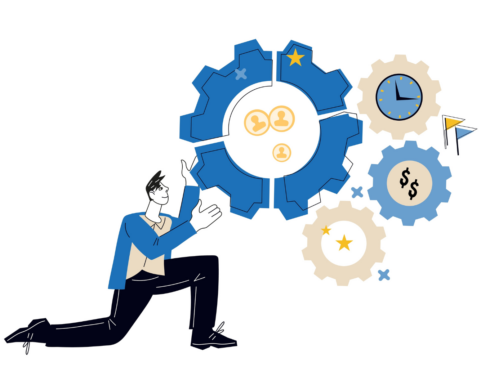
SUMMARY
LMS Was Designed As A Teacher’s Aid But It Now Needs To Be More Student-Centric
Learning Management System (LMS) is a cornerstone of any education institution aiming to provide effective learning. After being successful in corporate training and institutes dedicated to higher education, LMS has made inroads into the K-12 sector.
Initially, LMS was designed as a teacher’s aid and thus it was primarily built as a repository to store information. However, the philosophy of having an LMS in an educational institute has undergone a shift from being teacher-centric to student-centric.
Thus, a Learning Management System of tomorrow ought to be designed such that it helps students in their learning journey. Adaptive learning and assessment features coupled with predictive analytics can help bring forth positive learning outcomes.
Why A Learning Management System Was Designed?
Learning Management System (LMS) is a software application that aids in planning and executing the learning process.
Curriculum Planning
Prior to the beginning of an academic session, planning ought to be in place, so that it can be shared with all stakeholders – supervisors, teachers, students, parents etc.
A major challenge faced by principals and HODs is maintaining a consistent plan across multiple courses and monitoring the progress of the same. Sharing the course plan as hard copies result in a muddle too.
Teachers are not able to make alterations in the plan while the academic session is in progress. The chances of collaboration among teachers also reduce.
A LMS mitigates these concerns besides helping schools to go paperless.
Instant And Continuous Evaluation
Learning Management Systems currently support evaluation for objective as well as subjective questions. Automated evaluation is done for objective questions ranging from multi-response to text input ones.
Also, learners can attempt subjective questions online, and instructors can grade them on the platform itself. In a traditional classroom, students wait for weeks before they receive their answer scripts back after evaluation.
Instant evaluation provides them with immediate feedback, which can push them to improve if they have not fared well, or motivate them further if they have done well. Frequent conduct of exams and instant evaluations also help alleviate anxiety in students.
Engaging Learner
Learning is no longer limited to the four walls of a classroom. Students can browse through their lesson plans anytime, anywhere and take up what interests them at that moment. This also gives them the opportunity of studying at their own pace.
One curriculum model does not befit all kinds of learners. There are four kinds of learners – visual, auditory, reader/writer and kinaesthetic (VARK).
An LMS with adaptive learning technique personalises the lessons and its delivery as per the learning needs of each type of learner.
While these are the many requirements of LMS in the K-12 sector, its need in India is all the more dire.
Need Of LMS In India
Reduce Teacher Burden
Lack of quality teachers has often been cited as the reason marring the standard of education in India. Truly, there is a huge gap between the number of teachers available and the requirement.
In such a scenario, the present teachers are seen carrying out many duties. From marking attendance to checking answer scripts, from conducting parent-teacher meetings to making lesson plans manually, teachers have a lot on their plate.
An LMS can share their burden. From sending communications to parents to evaluating answer scripts, an LMS does it all. This concern has been addressed to a large extent by existing LMSs.
Improve Learning Outcomes
Rote learning methodology, with teachers delivering hour-long monologues to a class of more than 40 students, has plagued the Indian education system for long.
Education needs to enhance problem-solving and critical-thinking skills in students.
An LMS integrated with an effective curriculum can instill a lifelong love for learning in kids. An advanced LMS of future with adaptive learning features can address this concern.
LMS Of Yesteryear
The initial needs that led to the birth of Learning Management System were as follows.
- Teachers used LMS to keep a repository of their resource materials
Maintenance of files is a cumbersome task. Often, a bit of negligence or even a calamity like the breaking of fire or a cyclone can displace all valuables, resulting in a waste of all efforts.
- Students accessed files and resources from schools, when at home
When digital classrooms were introduced, it became a place where engagement and active learning took place. However, students were unable to avail similar learning at home. LMS helped them in accessing the files and resources at home.
- Students submitted their assignments
Submitting assignments on a digital platform is easier for students, and also easier for teachers to evaluate. It also helps in maintaining a record of students’ performance.
Thus, most of the LMSs available in the market are not able to cater to the needs of the present generation.
Learning Management System Of Yesterday Not Fit For Today
- Not teacher-friendly
With the availability of a wide range of tools and resources, teachers get confused. Creating rubrics is a cumbersome task. Thus, there is not enough teacher usage of LMS. Lack of training of teachers on LMS and motivation could be attributed as reasons for the low use.
- Not student-centric
The learning curve is steep and students feel pressured when new topics are introduced. The LMSs could perhaps be more student-centric then they are. They are unable to rise above the clutches of hierarchy in the education system. Student learning is still not controlled by them, but teachers.
- Costly maintenance
Maintenance of LMS software is a costly affair, especially when the software becomes older or the developer leaves the job. It is difficult to update the software or develop new features. In fact, developing a new LMS can actually be cheaper than maintaining an old one if the architecture is complex.
LMS Of Tomorrow For 21st Century Learning
The LMS has undergone an overhaul and transcended from being a virtual cabinet to an integrated learning platform, providing a holistic experience. Now it aims to facilitate peer interaction among students as well as open collaboration between teachers and parents.
Adaptive Learning and Assessment
Adaptive content: Based on a student’s response to a particular question, tools provide relevant hints, corrective feedback, and resources. There are different means of simulations, YouTube videos, notes etc. for imparting lessons.
Adaptive assessments: A mid-level question is presented to students. If they answer it correctly, the difficulty level of the subsequent question is raised and if they give an incorrect answer, the difficulty bar is lowered.
Thus, within a short period of time, a student’s learning progress and gaps in understanding the concepts can be identified. A future LMS should have adaptive learning and assessment integrated into it.
Predictive Learning Analytics
Learning analytics with the help of artificial intelligence identifies learning deficiencies and predicts ways to mitigate those. The best way to empower learners is to provide them with insights into their own learning. The instructors, too, can be notified if students are in need of a little more help so that the former can provide better guidance.
The very objective of predictive learning analytics is to avert a disaster. A student might show disinterest to a point where artificial intelligence might actually predict him/ her dropping off. To prevent it, positive interventions ought to be taken. Predictive learning analytics is not just about the prediction, it is about gaining insights to prevent a disaster.
Further, assessment should also point out reasons behind a student’s performance besides just evaluating them.
As students interact with artificial intelligence, the latter gains knowledge about them as a collective group and also as individuals. The information gained helps it understand their learning patterns, predict their future performance, and also point out reasons for poor performance if that is the case. For instance, a student might have performed poorly because of being unwell or distracted due to some reason.
A future LMS ought to be able to reveal such insights.
New-Age Integrated Content
As already mentioned earlier, the LMS ought to put students at the helm of their learning. The motive of designing new-age LMSs should not just be about pushing more or new information to the learners.
Past LMSs had failed to retain students, and that’s something that new LMSs need to address. It is important to engage and retain students as users.
Thus, information needs to be split into a number of small lessons with logical pauses, when students can stop and reflect.
In other words, byte-sized learning in the form of GIFs, audio, and video lessons can go a long way for students.
Moreover, it is the need of the hour to design an integrated curriculum solution where lab plans, digital classroom content and home lessons are in continuation and sync with each other.
Integration With ERP
It is essential that the LMS is well integrated with the school management software. A school management records all information – students’ attendance, their demographic and social details etc. Processing such data for individual students could be a difficult task for teachers.
Technology could help provide valuable insights into students’ performance. For instance, if a student has been on leave for a week and not fared well in exams, there could be a way to understand the poor performance.
Collaboration
Other than increased collaboration between all the stakeholders of the K-12 sector to meet learning outcomes, the future LMSs need to be more social in all possible ways.
Students across grades should be able to collaborate on various projects. Features like discussion forums, surveys or polls, publication of e-journals etc. can improve collaboration of students across grades.
Parents, who are otherwise much neglected in the learner’s learning process, also need to be brought into the fold of their child’s learning to improve the latter’s learning outcomes. A specialised parent portal would give them the opportunity to keep abreast of their child’s learning without interfering with their studies.
Scalability
At present, there is a lack of integration between LMS and other administrative systems. Future LMSs need to provide a better exchange of information and content so that they are available to users. This would enable teachers to add tools to the platform. It will also help in analysing student data more effectively and in designing a learning path suited to a particular student.
New projects, new enrolments, more involvement from students and teachers etc. tend to increase the load on the system, hence the network and process ought to be able to accommodate the growth.
A scalable Learning Management System a.ka. LMS ought to be able to manage a large amount of data and allow a large number of students to access the system at the same time.


























